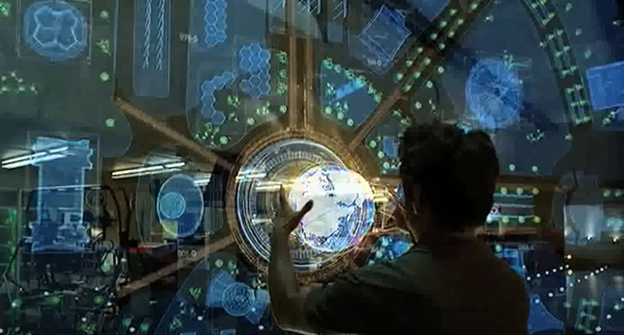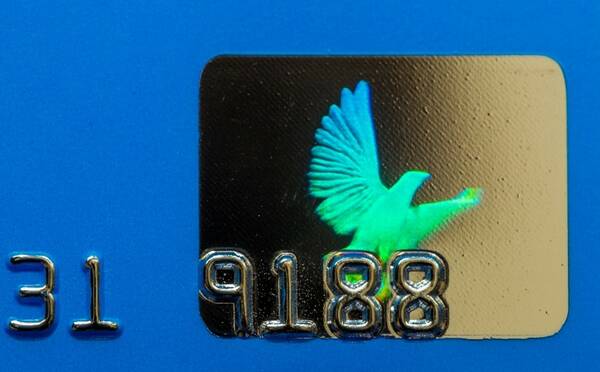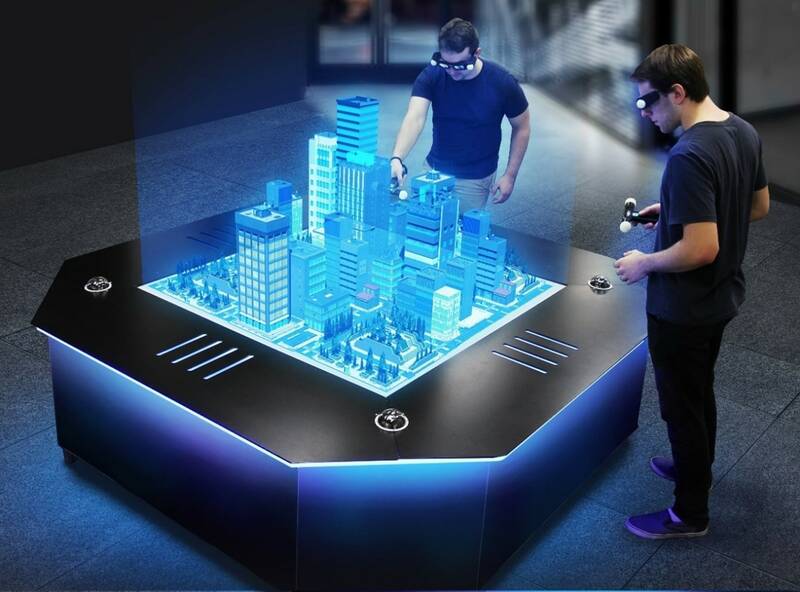Beam Me Up, Scotty: New Developments In Hologram Technology
Attendees of the recent Paramount+ Summit of Stars event in London were able to step onto the Star Trek: Discovery transporter platform and see themselves turned into holograms to be “beamed” to a nearby location, thanks to ARHT’s HoloPresence™ technology. Holographic displays have long been a staple of science fiction, from Princess Leia’s first appearance in the 1979 original Star Wars movie to the interactive, gesture-based displays in the Iron Man and Minority Report movies in the 2000s. New technology research and product developments are now bringing that future closer than ever.

Robert Downy Jr. as Iron Man interacts with a mid-air holographic display in the 2010 movie Iron Man 2. (Image © Marvel Entertainment/Walt Disney Company)
Technology of Holographic Displays
In today’s marketplace, the word “hologram” is applied to many types of 3D images, some of which are not truly holograms in the purest technological sense. A traditional hologram captures a three-dimensional image and shows it in a two-dimensional medium.1 To create a hologram, light is photographed (often by multiple cameras and/or from multiple angles) as it scatters off an object. The captured images are then projected on a flat surface, but appear to be three-dimensional.
Many holographic displays use a diffraction pattern to modify a light wavefront and re-create the image of an object. Typically, the image is projected onto an LCoS display surface using a Spatial Light Modulator (SLM) device, lasers, or super-luminous LEDs as the light source.2 You may even have a hologram in your wallet as credit cards and identification cards commonly use them as security features—just look for an iridescent image or water mark.

Security hologram on a credit card.
The Princess Leia hologram and similar 3D images shown floating in air are more accurately called volumetric displays. They are truly three-dimensional, with a nearly 360˚ viewing angle that enables viewers to walk around and see different sides of the object with the naked eye—no special glasses, headset or goggles. Volumetric displays are typically created by projecting images toward light-scattering, -emitting or -absorbing surfaces or particles, but can be found mostly in research labs. For example, recent research has used acoustic waves to suspend microparticles and move them through the air to trace holographic light paths.3
A research team at Brigham Young University used lasers to “trap” particles and create holographic images inspired by Star Wars.
Nevertheless, the idea of "hologram" meaning any image with a 3D appearance has taken hold in the popular imagination. Whatever they are called, innovators are working hard to bring these futuristic displays to the market and deliver a superior user experience. For example, a research team at Beihang University in China have developed the first holographic display that provides a wide field of view.
The team implemented two different hologram generation methods simultaneously: a tunable liquid crystal grating with an adjustable period to widen the viewing angle with secondary diffraction of the reconstructed image to increase the image size. The display system includes “a laser, a beam expander, a beam splitter, a spatial light modulator (SLM), a 4f system with two lenses, a filter, a polarized light valve, and a signal controller, in addition to the tunable liquid crystal grating.”4 In experiments, the system was able to achieve a viewing angle of 57.4°—more than six times the typical SLM hologram system that displays images with just a 9° view angle (images of <2 cm), which can be uncomfortable for human viewers.
Hologram Boxes Put You “In the Room Where it Happens”
The Star Trek display in London is just one example of a new category of hologram that is moving beyond entertainment and into the corporate, education, and medical markets. Like the ARHT system, these devices rely on a box or “portal” that displays a person’s live image. The subject is captured by a camera system in another location and then relayed to the box in real-time. For example, Los Angeles-based Proto™ (formerly Portl) offers both a life-size (7’ tall) and table-top version of its hologram box. Similarly, ARHT offers a full-size box and various portable display sizes.
Technically, these boxes create 2D holographic projections, not true holograms (volumetric images), but they offer no noticeable latency and create the effect of having a person in the room. The technology is already gaining popularity for live communication in place of video calls, and for enterprise applications such as lectures, presentations, and medical consultations.

Remote executive leads a team meeting via the ARHT CAPSULE platform. (Image © ARHT)
Proto demonstrated its holographic interaction platform Epic at the Creative Industries Expo at this year’s SXSW event, with the tagline “If you can’t be there, beam there.” Proto’s devices are already being used by The University of Central Florida’s School of Health Professions and Sciences to “beam” a doctor live from Australia to teach students on its Florida campus. These “holoportation” devices also hold potential for enhancing remote patient care, for example to diagnose Parkinson’s disease tremors or for speech-and-language pathology treatments.5
Meanwhile, other companies are exploring different platforms to create hologram-style 3D imaging and communications. For example, “Google is testing a booth with cameras and a glass screen where users can chat face-to-face with life-size, 3D images of each other. And Microsoft offers holograms viewed through virtual-reality headsets.”6

A hologram table from Axiom Holographics projects objects that appear to rise from the table’s surface up to roughly 1 meter high. (Image © Axiom Holographics)
Reach Out and Touch: Interactive Holograms with Touch Sensitivity
Touchscreens that display 3D images are already available on the market with products such as ATMs, hotel registration kiosks, and gaming monitors displayed at CES 2022. These devices create the experience of 3D holographic interaction but use traditional display technologies.
To help bring us closer to a future of truly interactive 3D holograms, researchers at Japan’s University of Tsukuba are working on methods to create images that not only float in the air but also are responsive to touch. Their technique “creates graphics in the air using a laser that emits ultra-short pulses of light. The high-intensity beam can break down air molecules through ionization, which produces short-lived specks of light, or plasma. The system renders images by rapidly adjusting the focal point of the laser in three dimensions, generating thousands of emission points, or voxels, per second.”7
The setup is nicknamed “Fairy Lights” and projects tiny hearts, stars, and fairies that are safe to touch. It uses femtosecond laser pulses, which have high peak intensity but are much less dangerous to humans than the nanosecond laser pulses used in previous experiments. In one demonstration, the system generated checkboxes in the air that could be selected by touching them with a finger.
The technology has a drawback, however. Even using safer femtosecond pulses, touching the images is still slightly uncomfortable, described by Ochiai as “like sandpaper or an electrostatic shock.”8
Measuring Quality and Accuracy of Holographic Displays
For 30 years, Radiant Vision Systems has been on the forefront of measuring light and color with precision systems that match the visual perception of the human eye. Our ProMetric® Imaging Photometers and Colorimeters can be used to quantify and qualify everything from LEDs and displays, to projected images and NIR laser emitters.
For example, we’ve worked with automobile manufacturers to measure 3D augmented reality head-up-display (AR HUD) projections. As holographic technologies continue to evolve and move towards market commercialization, Radiant continues to evolve our light and display measurement solutions to help product makers ensure the quality and accuracy of their devices.
CITATIONS
- Armao, M., “Hopeful Scientists Bring Holograms to Life,” Discover Magazine, May/June 2022 Issue, online April 22, 2022.
- Chinnock, C., “The Status of 8K & Light Field/Holographic Development,” presented at Society for Information Display (SID) LA Chapter One-Day Symposium, Los Angeles, CA, March 25, 2021.
- Fushimi, T., et al. “Acoustophoretic volumetric displays using a fast-moving levitated particle,” Applied Physics Letters, 115, 06410, published online August 5, 2019. DOI: doi.org/10.1063/1.5113467
- Li, Y. et al. “Tunable liquid crystal grating based holographic 3D display system with wide viewing angle and large size,” Light: Science & Applications, Vol 11, June 21, 2022. DOI: 10.1038/s41377-022-00880-y
- Landi, H., “A look at the most interesting innovations at SXSW 2022: from holograms to the future of psychedelics,” Fierce Healthcare, March 18, 2022.
- Ha, K., “When Your Boss Becomes A Hologram,” Bloomberg, March 3, 2022.
- Armao, M., “Hopeful Scientists Bring Holograms to Life,” Discover Magazine, May/June 2022 Issue, online April 22, 2022.
- Ibid.
Join Mailing List
Stay up to date on our latest products, blog content, and events.
Join our Mailing List
